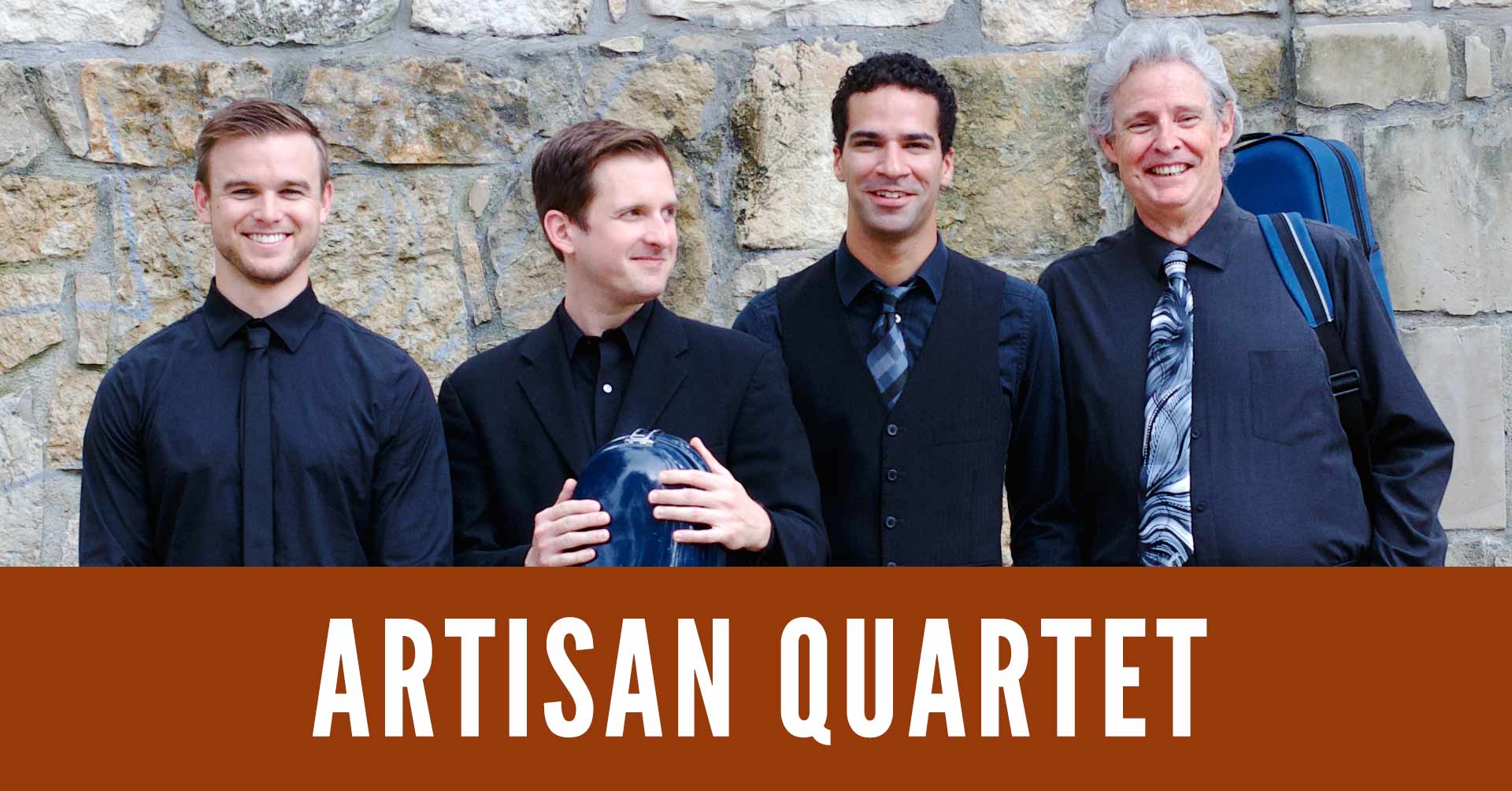ARTISAN QUARTET
Thursday, June 10 | noon
First Presbyterian Church
2408 N Navarro St
WOLFGANG AMADEUS MOZART (1756 – 1791)
String Quartet No.19 in C major, K.465
- Adagio — Allegro
- Andante cantabile
- Menuetto and Trio. Allegro
- Allegro
ANTONÍN DVOŘÁK (1841 – 1904)
String Quartet in F major, Op. 96
- Allegro ma non troppo
- Lento
- Molto vivace
- Finale: vivace ma non troppo
Patrice Calixte, violin
Caleb Hans Polashek, violin
Bruce Williams, viola
Douglas Harvey, cello

Sponsors
Cloyde & Ethel Lee Tracy Foundation
Rhea & Fred Fry
This concert is generously supported by our concert sponsors and by donors to the Victoria Bach Festival’s Annual Fund. Many thanks to our generous supporters!
About the Artists

In its brief history, the Artisan Quartet has performed many concerts around central Texas including at the Victoria Bach Festival several years in a row, the Mozart Festival Texas in San Antonio every Summer since 2012 – appointed Quartet in Residence in 2014, the Blanco (Texas) Performing Arts Association Series, the Twilight Series (Jonestown/Lago Vista), the Santa Cecilia Series (Austin), Texas State University (San Marcos), and the Salon Concert Series (San Antonio). In 2013, the Artisan’s completed their three season long “Genius at Play” Series, featuring the complete string quartets of Beethoven.
The group recorded portions of composer David Hamburger’s film score for Mat Hames’ documentary about Barbara Conrad Smith, the legendary Metropolitan Opera singer. The film, entitled “When I Rise” premiered to a standing ovation at its premiere during the SxSW film festival in Austin in March 2010 and aired February 2011 on PBS’s “Independent Lens” series. The film DVD is available for purchase from www.shoppbs.org.
MidAmerica Productions, Inc. invited the Artisan Quartet to make its Carnegie Hall debut performing on the Carnegie Hall Weil Recital Hall Chamber Music Series on March 22nd, 2012. The Artisan received a standing ovation for their sold out performance and rave reviews. The concert in New York was made possible with very generous gifts from the Classical Artist Development Foundation and the Amatius Foundation, and was commemorated by the Texas House of Representatives on March 13, 2013 with H.R. 703 read into the Texas Congressional Record with the Artisans present.
In collaboration with the Austin Symphony Orchestra, the quartet created the Artisan Quartet Series starting in 2012. This exciting chamber music series has features the greatest works in the string quartet and chamber music repertoire and has provided music lovers in Austin wonderful concerts in an intimate setting.
More recently, the Artisan Quartet has become the Quartet in Residence for both the Mozart Festival Texas in San Antonio, and the Texas Bach Festival in Georgetown where one of their members is the Director of Chamber Music. The Artisan has also joined forces with the Odeon Preservation Association in Mason, Texas to create the Mason Chamber Music Festival. After a very well received performance in Mason at the Odeon theater in May of 2015, the Artisan Quartet proposed a yearly chamber music festival during the Spring wildflower season. The OPA liked the idea and the MCMF become a reality April 1-3, 2016 and is planning the fifth sesason.
Patrice Calixte, Associate Concertmaster of the Austin Symphony, joined the quartet in 2019.
A Nod to “Papa Haydn”
Bohemian composer Antonín Dvořák wrote his String Quartet in F major during a summer break from his teaching position at the National Conservatory of Music in New York in 1893. Dvořák and his family were invited to spend the summer in a rural community of Czech immigrants in Spillville, Iowa. In this bucolic setting, the composer put the finishing touches on his “New World Symphony,” and wrote a string quartet and string quintet.
The quartet was nicknamed the “American,” and scholars have attempted to identify the precise influences of Native American, African American, or American folk melodies in the composition. However, some of the clearest musical references are to the folk music of Dvořák’s native Bohemia, particularly in the danceable rhythms of the third movement scherzo.
The composer reflected: “When I wrote this quartet in the Czech community of Spillville in 1893, I wanted to write something for once that was very melodious and straightforward, and dear Papa Haydn kept appearing before my eyes, and that is why it all turned out so simply. And it’s good that it did.”
The influence Austrian composer Joseph Haydn (1732-1809), Dvořák’s “Papa Haydn,” is also felt in Mozart’s String Quartet No. 19. The work was nicknamed the “Dissonance” quartet due to its slow and brooding introduction, which tested the traditional rules of harmony.
The “Dissonance” quartet was the sixth and final work in a of a set of six quartets that Mozart dedicated to Haydn and completed in January, 1785. In presenting the pieces to his friend and mentor, Mozart wrote, “Behold here, famous man and dearest friend, my six children. They are, to be sure, the fruit of long and arduous work, yet some friends have encouraged me to assume that I shall see this work rewarded to some extent at least, and this flatters me into believing that these children shall one day offer me some comfort. You yourself, dearest friend, have shown me your approval of them during your last sojourn in this capital.”
The admiring reflections of Mozart and Dvořák demonstrate “Papa Haydn’s” lasting influence on the traditional forms and figures for the string quartet.
Bohemian composer Antonín Dvořák wrote his String Quartet in F major during a summer break from his teaching position at the National Conservatory of Music in New York in 1893. Dvořák and his family were invited to spend the summer in a rural community of Czech immigrants in Spillville, Iowa. In this bucolic setting, the composer put the finishing touches on his “New World Symphony,” and wrote a string quartet and string quintet.
The quartet was nicknamed the “American,” and scholars have attempted to identify the precise influences of Native American, African American, or American folk melodies in the composition. However, some of the clearest musical references are to the folk music of Dvořák’s native Bohemia, particularly in the danceable rhythms of the third movement scherzo.
The composer reflected: “When I wrote this quartet in the Czech community of Spillville in 1893, I wanted to write something for once that was very melodious and straightforward, and dear Papa Haydn kept appearing before my eyes, and that is why it all turned out so simply. And it’s good that it did.”
The influence Austrian composer Joseph Haydn (1732-1809), Dvořák’s “Papa Haydn,” is also felt in Mozart’s String Quartet No. 19. The work was nicknamed the “Dissonance” quartet due to its slow and brooding introduction, which tested the traditional rules of harmony.
The “Dissonance” quartet was the sixth and final work in a of a set of six quartets that Mozart dedicated to Haydn and completed in January, 1785. In presenting the pieces to his friend and mentor, Mozart wrote, “Behold here, famous man and dearest friend, my six children. They are, to be sure, the fruit of long and arduous work, yet some friends have encouraged me to assume that I shall see this work rewarded to some extent at least, and this flatters me into believing that these children shall one day offer me some comfort. You yourself, dearest friend, have shown me your approval of them during your last sojourn in this capital.”
The admiring reflections of Mozart and Dvořák demonstrate “Papa Haydn’s” lasting influence on the traditional forms and figures for the string quartet.



